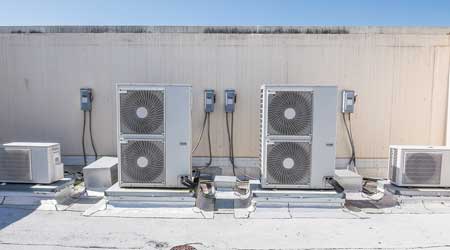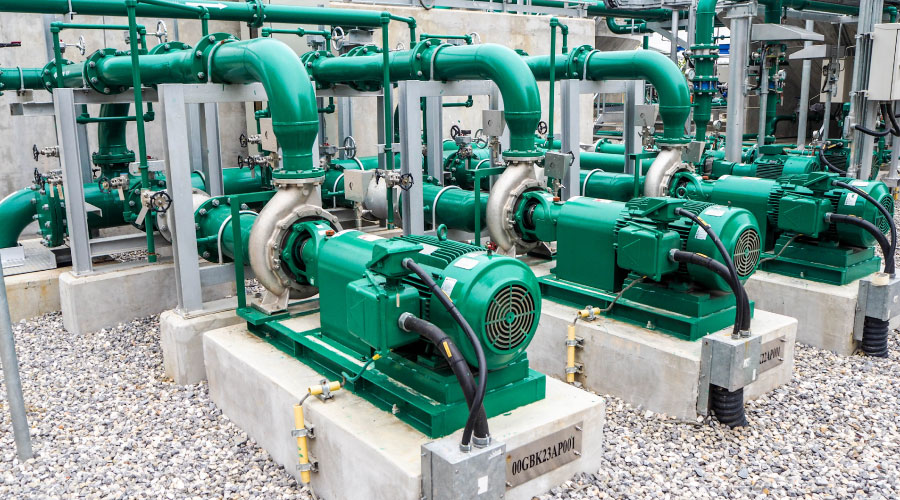Understanding High-Efficiency Rooftop Air Conditioning Units
Companies nationwide could save roughly $1 billion annually in energy costs by replacing 10- to 20-ton RTUs with units that meet the high performance RTU specification.
Rooftop air conditioning units (RTUs) condition about 60 percent of the U.S. commercial building floor area and consume 4.3 Quads of energy annually, according to U.S. Department of Energy statistics. Given the tremendous advances in high-performance RTUs developed in the past five years, facility managers may want to rethink waiting until older RTUs reach the end of their useful service life.
According to ASHRAE, most HVAC equipment can be expected to last 15 years. Of course, that assumes regular preventative maintenance is routinely performed and the system has no other issues, such as scarcity of refrigerant. Commercial ductless systems and single or multi-zone commercial RTUs easily achieve this lifespan. In fact, many well-maintained RTUs last 20 years or more.
The problem is standard RTUs — even some that are less than 10 years old — are significantly less efficient than units developed since 2013 in response to the U.S. Department of Energy (DOE)’s Advanced RTU Campaign.
“High-performance RTUs feature better equipment, variable speeds, more sophisticated controls, and fault detection,” says Antonio Bouza, technology manager of DOE’s Building Technologies Office. “Generally, these RTUs feature higher level components and parts, so when installed correctly, facilities managers can expect them to have a long and dependable life similar to the units they are replacing.”
High-performance specification
RTUs built according to the High Performance Rooftop Unit Specification can reduce energy use by 40 to 50 percent as compared to the 2016 ASHRAE 90.1 standard.
“Businesses nationwide would save about $1 billion each year in energy costs, if they replaced their 10- to 20-ton commercial units with units that meet this specification,” says DOE’s Better Buildings Alliance website.
When Walgreens began its program to strategically retire RTUs prior to failure, replacing them with high-efficiency units, the drug store chain realized more than $1 million in savings from material and labor budgets in just 150 stores.
The Advanced RTU Campaign recommends retiring inefficient RTUs for new high efficiency units that meet or exceed the Consortium for Energy Efficiency Tier II specification.
All major U.S. HVAC companies now offer high-performance units meeting the challenge RTU specification, according to Bouza. “So building owners can reach out to an HVAC contractor or vendor they have a relationship with and learn about that company’s high-performance RTUs,” he says.
The new high-efficiency RTUs are more costly than their conventional counterparts, says Ian M. Shapiro, senior engineer and founder of Taitem Engineering. But he believes building owners will be willing to pay the additional upfront costs, “if they can see significant energy savings.”
The efficiency gains are significant. Standard RTUs may have an Energy Efficiency Ratio (EER) of about 12, according to Andrew Lehrer, practice leader of high performance buildings at Environmental Systems Design, Inc. High-performance RTUs may have an Integrated EER (IEER) of 17 or more. “Further, evaporatively-condensed RTUs may reduce kilowatt per ton performance by 25 percent or more at (Air-Conditioning, Heating, and Refrigeration Institute) conditions,” he says.
“The (IEER) is important because that metric takes into account performance at partial load conditions at different capacities,” explains Bouza. In other words, it shows how the RTU will actually be operating on a daily basis rather than at its ideal full load capacity.
High-efficiency RTUs that meet DOE’s challenge have IEERs in the 20 to 21 range. So it’s not surprising that installing high-efficiency RTUs can yield significant savings. Recognized with a 2018 Advanced RTU Campaign Award, Walgreens replaced nearly 4,000 RTUs with high-efficiency units, resulting in more than 35.7 million kilowatt-hour savings.
Mass Save also received an award for the highest number of high-efficiency RTU installations through an efficiency program. Massachusetts’ energy solutions program reported nearly 6,500 high-efficiency RTU installations, resulting in more than 9.6 million kilowatt-hours of annual savings.
Rita Tatum, a contributing editor for Building Operating Management, has more than 30 years of experience covering facility design and technology.
Email comments and questions to edward.sullivan@tradepress.com.
Resources:
The U.S Department of Energy’s Better Buildings website offers an extensive toolkit to help evaluate and plan for RTU replacements or retrofits. Among the tools are these:
- The “RTU Comparison Calculator” compares high-efficiency rooftop air conditioners to standard equipment in terms of life cycle cost.
- “RTU Sizing Guidance” helps avoid common sizing mistakes.
- “High-Efficiency RTU Specification for Advanced RTU Campaign: CEE Tier II” covers efficiency and functionality characteristics that align with DOE’s Advanced RTU Campaign for new or replacement installations.
Related Topics:














